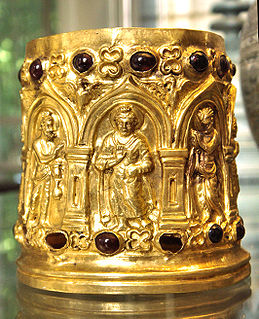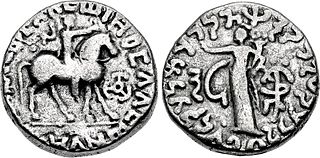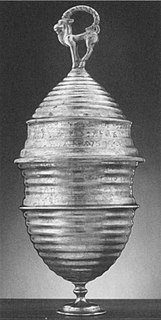
The Kharosthi script, also spelled Kharoshthi and Kharoṣṭhī, was an ancient Indo-Iranian script used by various Indo-European peoples in present-day northern Pakistan and eastern Afghanistan. It was used in Central Asia as well. Also known as 'Indo-Bactrian' and 'Aryan-Pali', the script was originally developed in northern Pakistan, between the 4th and 3rd century BCE. An abugida, it was introduced at least by the middle of the 3rd century BCE, possibly during the 4th century BCE, and remained in use until it died out in its homeland around the 3rd century CE.

The Indo-Greek Kingdom, or Graeco-Indian Kingdom, also known historically as the Yavana Kingdom (Yavanarajya), was a Hellenistic-era Greek kingdom covering various parts of Afghanistan and the northwest regions of the Indian subcontinent,. This kingdom was in existence from ca. 200 BC to ca. 1 BC.

Indo-Scythians were a group of nomadic Iranian peoples of Scythian origin who migrated from Central Asia southward into modern day Pakistan and North Western India from the middle of the 2nd century BCE to the 4th century CE.

Theodamas seems to have been an Indo-Greek ruler in the Bajaur area of Gandhara, in modern Pakistan.
Theodorus was a "meridarch" in the Swat province of the Indo-Greek kingdom in the northern Indian subcontinent, probably sometime between 100 BCE and the end of Greek rule in Gandhara in 55 BCE.

The Bimaran casket or Bimaran reliquary is a small gold reliquary for Buddhist relics that was found inside the stupa no.2 at Bimaran, near Jalalabad in eastern Afghanistan.

The Mathura lion capital is an Indo-Scythian sandstone capital from Mathura in Northern India, dated to the first decade of the 1st century CE. It was consecrated under the rule of Rajuvula, one of the Northern Satraps of the region of Mathura.

Kharahostes or Kharaosta was an Indo-Scythian ruler in the northern Indian subcontinent around 10 BCE – 10 CE. He is known from his coins, often in the name of Azes II, and possibly from an inscription on the Mathura lion capital, although another satrap Kharaostes has been discovered in Mathura.

The History of the Indo-Greek Kingdom covers a period from the 2nd century BCE to the beginning of the 1st century CE in northern and northwestern India. There were over 30 Indo-Greek kings, often in competition on different territories. Many of them are only known through their coins.
The Taxila copper-plate, also called the Moga inscription or the Patika copper-plate is a notable archaeological artifact found in the area of Taxila, Gandhara, in modern Pakistan. It is now in the collection of the British Museum.

The Apracharajas, also known as Avacarajas, were an Indo-Scythian ruling dynasty of present-day western Pakistan and eastern Afghanistan. The Apracharaja capital, known as Apracapura, was located in the Bajaur district of the Khyber-Pakhtunkhwa, Pakistan. Apraca rule of Bajaur lasted from the 1st century BCE to the 1st century CE.

Vijayamitra was an Indo-Scythian king of the Apracas who ruled in the north-western region of ancient India, located in Bajaur of modern Pakistan.

The Indo-Greeks practiced numerous religions during the time they ruled in present-day northwestern India from the 2nd century BCE to the beginning of the 1st century CE. In addition to the worship of the Classical pantheon of the Greek deities found on their coins, the Indo-Greeks were involved with local faiths, particularly with Buddhism, but also with Hinduism and Zoroastrianism.

Indo-Greek art is the art of the Indo-Greeks, who reigned from circa 200 BCE in areas of Bactria and the Indian subcontinent. Initially, between 200 and 145 BCE, they remained in control of Bactria while occupying areas of India, until Bactria was lost to invading nomads. After 145 BCE, Indo-Greek kings ruled exclusively in parts of ancient India, especially in Gandhara and the area of Punjab. The Indo-Greeks had a rich Hellenistic heritage and artistic proficiency as seen with the remains of the city of Ai-Khanoum, which was founded as a Greco-Bactrian city. In India, several Indo-Greeks cities are known such as Sirkap near Taxila, or Barikot, where some Indo-Greek artistic remains have been found, such as stone palettes. Some Buddhist cultural objects related to the Indo-Greeks are known, such as the Shinkot casket. But by far the most important Indo-Greek remains in India are the beautiful and numerous coins of the Indo-Greek kings, considered as some of the most artistically brilliant of Antiquity. Most of the works of art of the Greco-Buddhist art of Gandhara are usually attributed to the direct successors of the Indo-Greeks in India in the 1st century CE, such as the nomadic Indo-Scythians, the Indo-Parthians and, in an already decadent state, the Kushans. Many Gandharan works of art cannot be dated exactly, leaving the exact chronology open to interpretation. With the realization that the Indo-Greeks ruled in India until at least 10-20 CE with the reign of Strato II in the Punjab, the possibility of a direct connection between the Indo-Greeks and Greco-Buddhist art has been reaffirmed recently.

The Bajaur casket, also called the Indravarma reliquary, year 63, or sometimes referred to as the Avaca inscription, is an ancient reliquary from the area of Bajaur in ancient Gandhara, in the present-day Federally Administered Tribal Areas of Pakistan. It is dated to around 5-6 CE. It proves the involvement of the Scythian kings of the Apraca, in particular King Indravarman, in Buddhism. The casket is made of schist.

The Silver Reliquary of Indravarman is an inscribed silver Buddhist reliquary dedicated by Apracaraja king Indravarman in the 1st century BCE, which has been found presumably in the Bajaur area of Gandhara. Believed to have been fabricated at Taxila, the silver reliquary consists of two parts—the base and the cover—both being fluted, and the cover being topped by a figure of long horned Ibex. It has been dated to around the eighth or ninth decades of the 1st century BCE and bears six inscriptions written in pointillē style, in Kharoshthi script and Gandhari/north-western Prakrit. In form, the silver vessel is wholly atypical of Buddhist reliquaries and is said to have been a wine goblet, similar to others found in Gandhara and Kapisa regions. The vessel was later reused by Apraca king Indravarman as a Reliquary to enshrine Buddhist relics in a stüpa raised by Indravarman. The inscriptions on the silver reliquary provide important new information not only about the history of the kings of Apraca dynasty themselves but also about their relationships with other rulers of the far north-western region of traditional India i.e. modern northern Pakistan and eastern Afghanistan around the beginning of Christian era.

The Yavana Era, or Yona was a computational era used in the Indian subcontinent from the 2nd century BCE for several centuries thereafter, probably starting in 174 BCE. It was initially thought that the era started around 180-170 BCE, and corresponded to accession to the Greco-Bactrian throne of Eucratides, who solidified Hellenic presence in the Northern regions of India. The Greeks in India flourished under the reign of the illustrious, Menander - greatest of the Yavana rulers, who campaigned as far as Pataliputra, and South Asia. It is now equated with the formerly theorized "Old Śaka era".

Indravarman or Indravarma, also called Itravasu on his coinage, was an Indo-Scythian king of the Apracas, who ruled in the area of Bajaur in modern northwestern Pakistan. He was the son of Vispavarma. Indravarma had a son, Aspavarma, commander and later king, known from an inscription discovered at Taxila. Aspavarma also mentioned his father Indravarma on some of his coins.
Indravasu was an Indo-Scythian king of the Apracas in Bajaur, western Pakistan.
The Rukhuna reliquary, also sometimes Rukhana reliquary, also described as the Bajaur reliquary inscription, is a Scythian reliquary which was dedicated and inscribed in 16 CE by Rukhuna, Queen of Indo-Scythian king Vijayamitra. The inscription on the reliquary, also called the Bajaur reliquary inscription, was published by Richard Salomon with a photograph in 2005, and gives a relationship between several eras of the period, and especially a confirmation of a Yavana era in relation to the Azes era, that is "Azes era= Yavana era - 128 years".




















